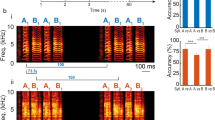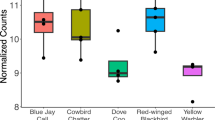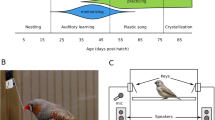Abstract
Nucleus HVc of the avian song system is a forebrain structure critical in song production, perception and learning. Here we show that most HVc neurons that respond to auditory stimuli under anesthesia show no responses to the same stimulus in the awake, unrestrained bird. This suppression of auditory responses in awake birds does not occur in the forebrain field L complex, which is one of the auditory input stages for HVc. Gating of auditory input at the junction between the auditory and vocal control system may be essential for regulating auditory feedback signals necessary for song learning and maintenance.
This is a preview of subscription content, access via your institution
Access options
Subscribe to this journal
Receive 12 print issues and online access
$259.00 per year
only $21.58 per issue
Buy this article
- Purchase on SpringerLink
- Instant access to full article PDF
Prices may be subject to local taxes which are calculated during checkout




Similar content being viewed by others
References
McCasland, J. S. Neuronal control of bird song production. J. Neurosci. 7, 23–39 (1987).
Margoliash, D. Functional organization of forebrain pathways for song production and perception . J. Neurobiol. 33, 671– 693 (1997).
Vu, E. T., Mazurek, M. E. & Kuo, Y.-C. Identification of a forebrain motor programming network for the learned song of zebra finches. J. Neurosci. 14, 6924–6934 (1994).
Yu, A. C. & Margoliash, D. Temporal hierarchical control of singing in birds. Science 273, 1871– 1875 (1996).
Brenowitz, E. A. Altered perception of species-specific song by female birds after lesions of a forebrain nucleus. Science 251, 303 –305 (1991).
Nottebohm, F., Stokes, T. M. & Leonard, C. M. Central control of song in the canary, Serinus canarius. J. Comp. Neurol. 165, 457– 486 (1976).
Vicario, D. S. & Yohay, K. H. Song-selective auditory input to a forebrain vocal control nucleus in the zebra finch. J. Neurobiol. 24, 488–505 (1993).
Doupe, A. J. & Konishi, M. Song-selective auditory circuits in the vocal control system of the zebra finch. Proc. Natl Acad. Sci. USA 88, 11339–11343 (1991).
Bottjer, S. W., Miesner, E. A. & Arnold, A. P. Forebrain lesions disrupt development but not maintenance of song in passerine birds. Science 224, 901–903 (1984).
Doupe, A. J. A neural circuit specialized for vocal learning. Curr. Opin. Neurobiol. 3, 104–111 (1993).
Margoliash, D. Preference for autogenous song by auditory neurons in a song system nucleus of the white-crowned sparrow. J. Neurosci. 6, 1643–1661 (1986).
Margoliash, D. & Fortune, E. S. Temporal and harmonic combination-sensitive neurons in the zebra finch's HVc. J. Neurosci. 12, 4309–4326 (1992).
Lewicki, M. S. Intracellular characterization of song-specific neurons in the zebra finch auditory forebrain. J. Neurosci. 15, 5854 –5863 (1996).
Lewicki, M. S. & Arthur, B. J. Hierarchical organization of auditory temporal context sensitivity. J. Neurosci. 16, 6987–6998 (1996).
Fortune, E. S. & Margoliash, D. Parallel pathways and convergence onto HVc and adjacent neostriatum of adult male zebra finches (Taeniopygia guttata). J. Comp. Neurol. 360, 413–441 (1995).
Vates, G. E., Broome, B. M., Mello, C. V. & Nottebohm, F. Auditory pathways of caudal telencephelon and their relation to the song system of adult male zebra finches (Taenopygia guttata). J. Comp. Neurol. 366, 613–642 (1996).
Volman, S. F. Quantitative assessment of song-selectivity in the zebra finch "high vocal center". J. Comp. Physiol. A 178, 849– 862 (1995).
Metzner, W. An audio vocal interface in echolocating horseshoe bats. J. Neurosci. 13, 1899–1915 (1993).
Mueller-Preuss, P. & Ploog,D. Inhibition of auditory cortical neurons during phonation. Brain Res. 215, 61–76 (1981).
Capsius, B. & Leppelsack, H. J. Influence of urethane anesthesia on neural processing in the auditory cortex analogue of a songbird. Hearing Res. 96, 59–70 (1996).
McCasland, J. S. & Konishi, M. Interactions between auditory and motor activities in an avian song control nucleus. Proc. Natl Acad. Sci. USA 78, 7815– 7819 (1981).
Konishi, M. The role of auditory feedback in the control of vocalization in the white-crowned sparrow. Z. f. Tierpsychol. 22, 770– 783 (1965).
Price, P. H. Developmental determinants of structure in zebra finch song. J. Comp. Physiol. Psychol. 93, 260–277 (1979).
Nordeen, K. W. & Nordeen, E. J. Auditory feedback is necessary for the maintenance of stereotyped song in adult zebra finches . Behav. Neural Biol. 57, 58– 66 (1992).
Okanoya, K. & Yamaguchi, A. Adult bengalese finches (Lonchura striata var. domestica) require real-time auditory feedback to produce normal song syntax. J. Neurobiol. 33, 343 –356 (1997).
Woolley, S. M. N. & Rubel, E. W. Bengalese finches Lonchura striata domestica depend upon auditory feedback for the maintenance of adult song. J. Neurosci. 17, 6380– 6390 (1997).
Reinke, H. & Wild, J. M. Identification and connections of inspiratory premotor neurons in songbirds and budgerigar. J. Comp. Neurol. 391, 147–163 (1998).
Striedter, G. F. & Vu, E. T. Bilateral feedback projections to the forebrain in the premotor network for singing in zebra finches. J. Neurobiol. 34, 27– 40 (1998).
Vates, G. E., Vicario, D. S. & Nottebohm, F. Reafferrent thalamo-"cortical" loops in the song system of oscine songbirds. J. Comp. Neurol. 380, 275–290 (1997).
Maunsell, J. H. R. The brain's visual world: representation of visual targets in cerebral cortex . Science 270, 764–769 (1995).
Newsome, W. T. Visual attention: spotlights, highlights and visual awareness. Curr. Biol. 6, 357–360 (1996).
Desimone, R. Neural mechanisms for visual memory and their role in attention. Proc. Natl Acad. Sci. USA 93, 13494– 13499 (1996).
Treue, S. & Maunsell, J. H. R. Attentional modulation of visual motion processing in cortical areas MT and MST. Nature 382, 539–541 (1996).
Todt, D. & Hultsch, H. in Verhaltensbiologie. (eds G. Tembrock, R. Siegmund and M. Nichelmann) 22– 27 (G. Fisher, Jena, Germany, 1986).
Waser, M. S. & Marler, P. Song learning in canaries. J. Comp. Physiol. Psychol. 91, 28– 35 (1976).
ten Cate, C. The influence of social relations on the development of species recognition in zebra finch males. Behaviour 91, 263– 285 (1984).
Li, R. & Sakaguchi, H. Cholinergic innervation of song control nuclei by the ventral paleostriatum in the zebra finch: a double-labeling study with retrograde fluorescent tracers and choline acetyltransferase immunohistochemistry . Brain Res. 763, 239–246 (1997).
Wenk, G. L. The nucleus basalis magnocellularis cholinergic system: one hundred years of progress. Neurobiol. Learn. Mem. 67, 85–95 (1997).
Schmidt, M. F. & Perkel, D. J. Slow synaptic inhibition in nucleus HVc of the adult zebra finch. J. Neurosci. 18, 895–904 (1998).
Margoliash, D. Acoustic parameters underlying the responses of song-specific neurons in the white-crowned sparrow. J. Neurosci. 3, 1039 –1057 (1983).
Acknowledgements
We thank P. Drew and A. Leonardo for technical help with some of the field L data, A. Leonardo for help with the acquisition and analysis software, M. Walsh and J. Pine for help with many of the electronic details of the chronic recording setup and M. Kohwi, G. Laurent, A. Leonardo and D. Perkel for comments on this manuscript. This research was supported by grants from National Institutes of Health (NRSA DC00125 and R03 DC03041 to M.F.S. and NH55984 to M. K. and M.F.S.).
Author information
Authors and Affiliations
Corresponding author
Rights and permissions
About this article
Cite this article
Schmidt, M., Konishi, M. Gating of auditory responses in the vocal control system of awake songbirds . Nat Neurosci 1, 513–518 (1998). https://doi.org/10.1038/2232
Received:
Accepted:
Issue date:
DOI: https://doi.org/10.1038/2232
This article is cited by
-
Dynamic FoxP2 levels in male zebra finches are linked to morphology of adult-born Area X medium spiny neurons
Scientific Reports (2020)
-
Intrinsic neuronal properties represent song and error in zebra finch vocal learning
Nature Communications (2020)
-
Duets recorded in the wild reveal that interindividually coordinated motor control enables cooperative behavior
Nature Communications (2019)
-
Auditory experience-dependent cortical circuit shaping for memory formation in bird song learning
Nature Communications (2016)
-
Anesthesia and brain sensory processing: impact on neuronal responses in a female songbird
Scientific Reports (2016)



